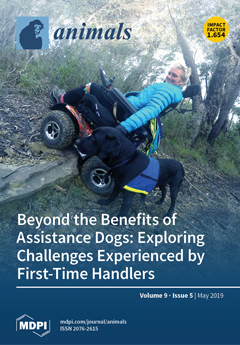The association between parasite isolates, including
Buxtonella sulcata, in suckling and post-weaning calves and diarrhea was studied with the aim to control diarrhea caused by
B. sulcata. A total of 1100 diarrheic fecal samples were collected from 609 suckling calves and
[...] Read more.
The association between parasite isolates, including
Buxtonella sulcata, in suckling and post-weaning calves and diarrhea was studied with the aim to control diarrhea caused by
B. sulcata. A total of 1100 diarrheic fecal samples were collected from 609 suckling calves and 491 post-weaning calves with diarrhea. Salt floatation and modified Ziehl–Neelsen techniques were applied for the microscopic examination of the presence or absence of parasite eggs and oocysts/cysts. The microscopic findings revealed that 20.36% of the calves had parasitic diarrhea, with a prevalence rate of 19.54% in suckling calves and 21.38% in post-weaning calves. The most frequently detected parasites according to morphological characters were
Eimeria species,
Buxtonella sulcata,
Toxocara vitulorum,
Cryptosporidium species, and
Moneizia species. In suckling calves,
Eimeria species,
B. sulcata, and
T. vitulorum had the highest prevalence rates of infection, corresponding to about 37.14%, 32.86%, and 20.00%, respectively. However, in post-weaning calves,
B. sulcata infection was more prevalent (30.15%) than infections with
Eimeria species and
T. vitulorum. The highest parasite score density was found in multiple infections with
B. sulcata, Eimeria species, and
T.
vitulorum; however, the score density of
B.
sulcata when present alone in the fecal specimens was higher than in specimens co-infected with other parasites. The risk factors affecting the prevalence rate of parasitic diarrhea, such as sex, season, housing system, and feed stuff, are discussed. Concerning the treatment of diarrhea caused by
B. sulcata in post-weaning cattle calves, 20 calves were divided into 4 equal groups. Group A was given sulphadimidine sodium (1.0 g/10 kg body weight) and metronidazole (500 mg/40 kg body weight); group B was treated with oxytetracycline hydrochloride (500 mg/45 Kg of body weight) and metronidazole (500 mg/40 kg body weight); group C was daily administered garlizine (allicin), 2 g/ L in drinking water; group D was the untreated control group. All medications were administered orally for four successive days. The results showed that the cyst count was significantly lower in the drug-treated groups, and the metronidazole + oxytetracycline hydrochloride and metronidazole + sulphadimidine combinations achieved 98.77% and 96.44% efficacy, respectively. Garlizine had 72.22% efficacy. Intriguingly,
B. sulcata infection was associated with other parasitic infections, but
B. sulcata mono-infection was the most common cause of diarrhea. Moreover, the combinations of oxytetracycline hydrochloride or sulphadimidine with metronidazole are recommended to control buxtonellosis in calves. Further studies are recommended to investigate the bacterial, viral, and fungal infections associated with
B. sulcata infection.
Full article






